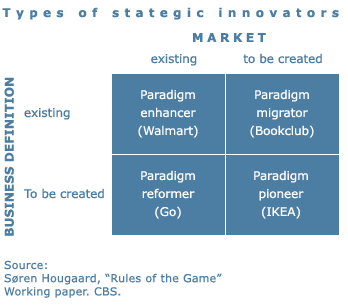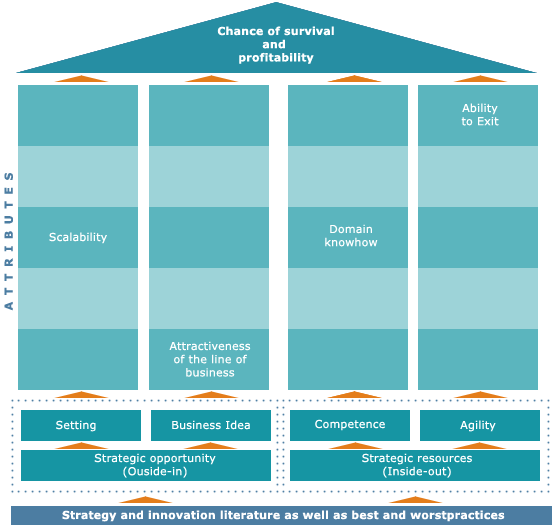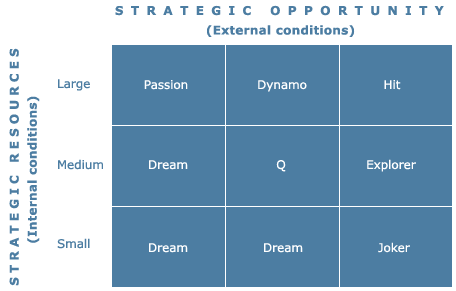The Basis of Hit Rater™.
Cornerstone 1 – Theory and Practice Under the Same Hat
Hit Rater is developed as a modular, accurate, fast and reliable standard method for analysing business cases. With Hit Rater the user can, as required, get a quick view, a thorough insight or both.
Hit Rater is definitely not designed out of the blue. In the following, the theoretical and practical basis of Hit Rater will be presented. Here the user can become familiar with the philosophy and the model as well as the sources Hit Rater is built on and make his or her own impression of the validity and embeddedness of the method.
Not two business cases are the same and entrepreneurship is generally a complicated and multi-faceted concept. Therefore, you also have to be careful not to apply one single formula to entrepreneurship and equally careful in the interpretation of the results of the analyses. As a standard method, Hit Rater is, of course, also simplifying and limiting. It is a natural consequence. This is why Hit Rater is and will only be an indicator of and a supplement to the individual assessment of the business cases.
However, Hit Rater’s strength is in the making of this method which originates from the combination of theory and practice. Entrepreneurship is a discipline where none of these approaches can be neglected. Entrepreneurship contains elements of academic-analytic and of practical-trade character. That is known by everyone who has worked with this – the world’s most exciting – challenge, namely the creation of a completely new business.
Cornerstone 2 – No Sure Recipe for Success
Unfortunately there is no recipe for how to be successful with an entrepreneurship project. If such a recipe existed, everyone would probably follow it. The fact is that over half of all start-up businesses have to shut down within five years and only about one out of ten develops into actual growth businesses.
In retrospect, it seems natural enough that it was Dell, Microsoft, Amazon, Google, Facebook, Cisco, Skype, Giga…. that came out as winners. Because they had the visions, instincts, resources and the will and their timing was perfect. So everyone can see now. But at the times when the battles were fought, there were many other just as ambitious and professional innovative businesses than the ones that won and only a few people could actually point out the favourites. Only history knew.
Successful entrepreneurs have priceless experience to take with them. This is also the case for experienced venture capitalists as most of them have a background as entrepreneurs. You have to listen to and learn from all those people, who have led the way. At the same time, it is also allowed to be a bit critical. It is true that history knows, but it is not repeating itself. Both belong to the basis of Hit Rater.
Cornerstone 3 – Everyone Has a Chance
It is not predetermined who will choose to become an entrepreneur. Nor is it possible to point out beforehand which of them that will be successful with what and why. Everyone has a chance.
Of course, this does not mean that any business case will have good prospects of getting a commercial breakthrough. Some ideas are better thought-out than others. More at the cutting edge. Closer to the customers’ needs. More visionary. Or rights-protected. Some people just have the extra skills, energy and will that are required. To this you can add luck.
However, no one is a born entrepreneur. Contingencies very much come into play. The entrepreneurial talent is, on the other hand, not equally developed for all. But it is very much a question of choices and consequences that determines whether you will become an entrepreneur.
Cornerstone 4 – The Contribution of Strategy Research to Explain Success
Strategy research (and market research) takes up much of the literature on entrepreneurship. Thus many people regard entrepreneurship as a strategy field. A standard method for analysing new innovative business cases should therefore include the strategy research contribution as a central ingredient.
Strategy research is extensive and luckily relatively coherent. This research and the literature created by the research have put their fingerprints on Hit Rater. In a very condensed form, the strategy research can be boiled down to the following trends:
Fig. The strategy research contribution to insight into entrepreneurship

Source: Inspired by Mintzberg Henry, Ahlstband Bruce and Lampel Joseph: ”Strategy Safari”. The Free Press. New York. 1998.
The figure illustrates the different perspectives characterising the schools of strategy research, for instance in relation to innovation and thus the development of new business.
Some principal schools of thought argue in favour of the outside-in perspective. Others are based on the inside-out perspective. In theory, they are mutually exclusive.
The essence of the four principal schools of thought within strategy research is included in the method framework of Hit Rater. ”The school of positioning” is the one which entrepreneurs usually base their business cases on. The core of the business plan is ”the value proposition” – the position in the market you wish to conquer. Râison d’etre.
The school of ”cultural pattern” has delivered convincing documentation of the fact that core competences (competences that are unique, rare, relevant and non-copyable) are the key to long-term success. Converted into business cases, this means that the team’s competences and motivation should be analysed as the possibly decisive factor.
The schools of positioning and competence represent each other’s theoretical contrasts. An analysis method for assessment of business cases claiming to be reliable must, however – despite the risk of scientific “manipulation” – include both these basic schools. Entrepreneurship is a practical discipline which can neither ignore the opportunities nor the competences.
The school of entrepreneurship claims that strategy is a vision-driven individual process with the charismatic leader in the centre. This approach is opportunity-driven like the school of positioning, but attaches crucial importance to the creative, disruptive destruction created by the great, rare personality (the entrepreneur). The born entrepreneur who will spot the opportunity before it becomes evident to everyone.
Strategy and thus entrepreneurship as ”configuration” see the world as a biological system where forces seeking balance and the coexistence of the species, are disrupted by imbalance, chaos and “bangs” from which new integrative forces will evolve again. If you want to analyse business cases, you have to relate to the total circuit and in which phases the surrounding ecosystems are.
So, Hit Rater includes and uses all the perspectives from the treasure chest of strategic research. Each in their own way, they present very relevant views regarding business cases and success factors. This view can be summarized as follows
Cornerstone 5 – The Contribution of Innovation Research
Innovation research has delivered its own independent and considerable contribution to the understanding of the characteristics and success factors of the entrepreneurial process. In order to analyse a business case objectively, it is therefore logical to reflect it in the models, rationale and empiric results of the innovation literature.
For a deeper and more systematic discussion of the most important principles and ideas from the innovation research, which has influenced the design of Hit Rater significantly, please refer to:
Working paper "What is innovation"?
Supplementary bibliography.
Innovation means to create and develop new business. In this way, innovation and entrepreneurship are two inseparable elements. Innovation is the source of entrepreneurship. Entrepreneurship is the implementation of business innovation.
The research within innovation is not evolutionary in the same way as strategy research. It does not form a progressive pattern (yet).
Here are a few samples of the typologies within the innovation research:
Fig. Example of the contribution of innovation research

The Henderson-Clark typology shows the main types of innovations (= business cases) and indicates the established suppliers’ possibility of retaliation against an entrepreneurial business.
Another way to illustrate the chances and risks of an upcoming business case is to look at the bridging between the market and the business definition.

Source: Søren Hougaard: ”Spillets regler”. Working paper. CBS.
The research within innovation is rich in typologies and development theories. For instance, it is interesting to note that the innovation research does not write off or exclude any of the four schools of strategy. On the contrary.
In Hit Rater, models and typologies, which originate from the innovation literature, are used directly.
The market-orientated approach to entrepreneurship is widely discussed. Are the customers right? One of the world’s leading innovation researchers has concluded the following:
IV. How to cope with innovation in strategy?
Clayton M. Christensen: The Innovator's dilemma. Harvard Business School Press. 1997
Markedsorienteringens paradox:
..."But the value of understanding this history is that out of its complexity emerge a few stunningly simple and consistent factors that have repeatedly determined the success and failure of the industry's best firms. Simply put, when the best firms succeeded, they did so because they listened
responsively to their customers and invested agressively in the technology, products and manufacturing capabilities that satisfied their
customers' next generation needs. But, paradoxially, when the best firms subsequently failed, it was for the same reasons - they listened
responsively to their customers and invested agressively in the technology, products and manufacturing capabilities that satisfied their
customers' next generation needs. This is one of the innovator's dilemmas: Blindly following the maxim that good managers should keep
close to their customers can sometimes be a fatal mistake....."
Cornerstone 6 – The Observations of the Hit Rater Designer
As we all know, you cannot take the liberty of generalising from subjective observations or personal experience. But it is not dishonest to include the observations and “count them in” if the observer is skilled, dissociating, critical-analytic and capable of handling search-learning processes through which you at the same time include different observations and the relevant theory.
It is exactly in this way that the observations and personal case studies of the Hit Rater designer have become useful. They include approx. 25 years of intense practical experience within the field of venture capital as investor, director and consultant. Furthermore, they include the start-up of more than 10 businesses as entrepreneur or co-entrepreneur, to which must be added coaching and teaching at universities. In short, a long life with business cases in many different aspects, phases and industries.
Cornerstone 7 – The Hit Rater Master Model
The Hit Rater Master model has been designed on the basis of the modules 1-6.
The model seeks to include the most important research and literature within the field of strategy and innovation.
In the preparation of the master model and the subsequent design of the actual questions, the designer has listed three groups of real-life business cases which he has followed closely during a long period of time with approx. 25 cases in each group: (1) the successful ones, (2) the mediocre ones and (3) the ones that failed. These ”control groups” have worked as mirrors/simulators in relation to the (theory-based) theses on success factors/attributes, which the theoretic derivation has led to.
Fig. The Hit Rater Master Model

As it appears, Hit Rater operates with two main variables: (a) the strategic opportunity as synonym of the outside-in perspective versus (b) the strategic resources as the expression of the inside-out theory. Each of these main variables is decomposed in two “bars” or subvariables. Business idea and setting are the representative subvariables covering the strategic opportunity whereas competence and agility are covering the strategic resources.
The 5X4 resulting generic attributes are the 20 key factors that are analysed in Hit Rater. In the figure, four of these generic attributes are expresses as a flavour. Whether the selected subvariables and generic attributes are final depends on the users’ experiences with Hit Rater.
Cornerstone 8 – Hit Rater Result Matrix
The Hit Rater result is reported in two ways. Quantitatively in the shape of nominal scores and qualitatively in the shape of archetypes. It is assumed that all business cases can be placed in an archetype matrix with the strategic opportunity and the strategic resources as axes.

The portrayal of business cases in 7 archetypes holds a significant simplification, but is still providing an important straw in the wind for the characteristics and strength profile of the project.
Cornerstone 9
Hit Rater is available and is used every day by different players in different industries. All Hit Rater data and scores are stored in one central database on the server hosting Hit Rater.
In time, the users of Hit Rater will be able to analyse their own business cases in relation to a comparable population. This ”Hit Rater Intelligence” may contribute to a strengthening of the method.